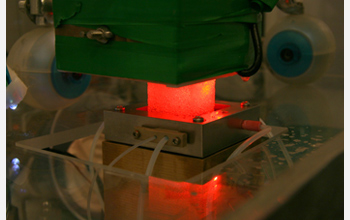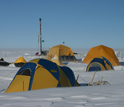|

Press Release 08-142
Greenland Ice Core Reveals History of Pollution in the Arctic

Coal burning in Northern Hemisphere leaves potentially harmful heavy metal legacy
August 18, 2008
View a video interview of researcher Joe McConnell of the Desert Research Institute.
New research, reported this week in the online early edition of the Proceedings of the National Academy of Sciences, finds that coal burning, primarily in North America and Europe, contaminated the Arctic and potentially affected human health and ecosystems in and around Earth's polar regions. The study, titled "Coal Burning Leaves Toxic Heavy Metal Legacy in the Arctic," was conducted by the Desert Research Institute (DRI), Reno, Nev. and partially funded by the National Science Foundation. Detailed measurements from a Greenland ice core showed pollutants from burning coal--the toxic heavy metals cadmium, thallium and lead--were much higher than expected. The catch, however, was the pollutants weren't higher at the times when researchers expected peaks. "Conventional wisdom held that toxic heavy metals were higher in the 1960s and ‘70s, the peak of industrial activity in Europe and North America and certainly before implementation of Clean Air Act controls in the early 1970s," said Joe McConnell, lead researcher and director of DRI's Ultra-Trace Chemistry Laboratory. "But it turns out pollution in southern Greenland was higher 100 years ago when North American and European economies ran on coal, before the advent of cleaner, more efficient coal burning technologies and the switch to oil and gas-based economies," McConnell said. In fact, the research showed pollutants were two to five times higher at the beginning of the previous century than today. Pollution levels in the early 1900s also represented a 10-fold increase from preindustrial levels. Continuous, monthly and annually averaged pollution records taken from the Greenland ice core dating from 1772-2003 produced the results. And although data showed heavy-metal pollution in the North Atlantic sector of the Arctic is substantially lower today than a century ago, McConnell and his research partner, Ross Edwards, an associate research professor at DRI, said there is still cause for concern. "Contamination of other sectors may be increasing because of the rapid coal-driven growth of Asian economies," they wrote in the report. They argued the consequence may be greater risk to the food chain as toxic heavy metals from industrial activities in Asian nations are transported through the atmosphere and deposited in the polar regions. Food chain contamination through toxic metal absorption from both the environment and from consumption of contaminated food sources could make its way to humans, who feed on long-lived land and marine animals such as caribou, seals and whale. "Impacts on human health in the Arctic region haven't been determined," said McConnell. But he suggested cleaner burning coal technologies, or better yet reduced reliance on coal burning, may head off the potential problem.
-NSF-

Media Contacts
Bobbie Mixon, NSF (703) 292-8485 bmixon@nsf.gov
Greg Bortolin, Desert Research Institute (775) 673-7465
Program Contacts
William J. Wiseman, NSF (703) 292-4750 wwiseman@nsf.gov
Principal Investigators
Joe McConnell, Desert Research Institute (775) 673-7348

The National Science Foundation (NSF) is an independent federal agency that
supports fundamental research and education across all fields of science and
engineering, with an annual budget of $6.06 billion. NSF funds reach all 50
states through grants to over 1,900 universities and institutions. Each year,
NSF receives about 45,000 competitive requests for funding, and makes over
11,500 new funding awards. NSF also awards over $400 million in
professional and service contracts yearly.
 Get News Updates by Email Get News Updates by Email
Useful NSF Web Sites:
NSF Home Page: http://www.nsf.gov
NSF News: http://www.nsf.gov/news/
For the News Media: http://www.nsf.gov/news/newsroom.jsp
Science and Engineering Statistics: http://www.nsf.gov/statistics/
Awards Searches: http://www.nsf.gov/awardsearch/
| 



